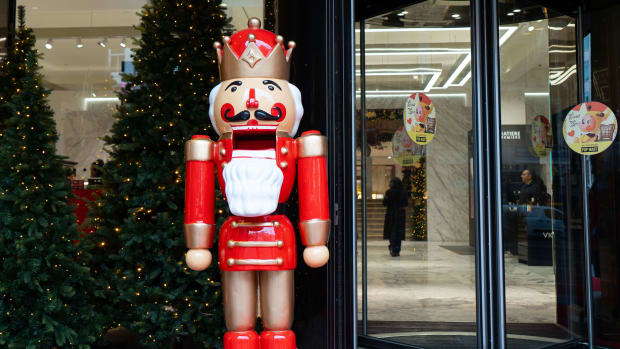
How the internationality of Amsterdam is driving out Sinterklaas
Sinterklaas will set foot ashore again this weekend, but there is little sign of his arrival in the capital. In an increasingly international Amsterdam, the old Dutch tradition is slowly giving way to an international Christmas spirit, professor Peter Jan Margry also agrees.
Whereas in the past, around this time of year, the Bijenkorf department store was decorated with red velvet mitres, climbing Petes and sweets, now Christmas trees and nutcracker dolls stand in the shop windows. The same applies to other shopping streets in Amsterdam: the unwritten rule that Christmas decorations could only appear after Sinterklaas seems to have been definitively forgotten in the capital. And that while this weekend, the saint officially returns to our country from Spain.
“Since the end of the twentieth century, retailers have been investing less and less in Sinterklaas decorations, especially in Amsterdam,” confirms Professor Peter Jan Margry, who specializes in European cultural anthropology. He sees that not only is Sinterklaas less visible in shop windows, but that Sinterklaas is celebrated less in the Netherlands as a whole.
The fact that Sinterklaas is generally celebrated less is also evident from research conducted by ABN Amro: in 2023, 52 percent of Dutch consumers celebrated Sinterklaas, and in 2024, only 46 percent. Five percent fewer Dutch people have bought gifts for Sinterklaas celebrations in 2024 compared to the previous year. And it turns out that the younger the generation, the more people buy Christmas gifts.

International Amsterdam
According to Margry, there are two main reasons why Sinterklaas celebrations are declining, and one of them plays a greater role in Amsterdam than in the rest of the Netherlands. That is: the impact of the capital’s internationalization on commerce.
“In Amsterdam, shops have a large non-Dutch audience. Firstly, most of the country’s tourists are in Amsterdam, and secondly, there are many expats here,” says Margry, “who, incidentally, are completely unfamiliar with Sinterklaas.” For foreign audiences, Christmas is more recognizable and therefore more commercially attractive to retailers. Installing a new window display is expensive, so it is more attractive for retailers to invest in a Christmas window display only, rather than first setting up a Sinterklaas window display and then a Christmas window display, says Margry. “Only bakeries still participate in Sinterklaas by selling speculaas and marzipan, and bookshops that still wrap their books in Sinterklaas paper.”
Black Pete debate
In addition to the impact of internationalization on shops in Amsterdam, the Black Pete debate has also thrown a spanner in the works. Margry: “The Black Pete debate has been going on for years. This has caused some discomfort and dissatisfaction among many Dutch people. Ultimately, this has taken away some of the fun of celebrating Sinterklaas for a number of people.” As a result, fewer people have started celebrating Sinterklaas.
Research by Ipsos I&O shows that indeed the Black Pete debate has caused fewer people to enjoy celebrating Sinterklaas. The research shows that two out of three (65 percent) Dutch people believe that “a small minority of opponents are ruining the Sinterklaas celebrations,” referring to the group of people who want to abolish Black Pete. Another striking finding in this study is that while soot Pete has become increasingly accepted over the past ten years, in 2024 there was an increase for the first time in the number of Dutch people who support the traditional Black Pete (38 percent).
According to Peter Jan Margry, the Sinterklaas festival is culturally unique and typical of the Netherlands. “You can tease people in poems without getting yourself into trouble or really hurting anyone.” Writing teasing poems and making surprises is something typically Dutch that you don’t find in other cultures, says Margry.
Traditions remain in homes
According to Margry, we cannot stop Sinterklaas celebrations from declining in the Netherlands: “You cannot force people to celebrate Sinterklaas if they do not want to. You cannot put a gun to someone’s head and make them write a poem.”
But we don’t need to fear the complete disappearance of Sinterklaas, says Margry. “It will become less visible on the streets and in society, but indoors, within families, it will continue to be celebrated. In these family settings, people will hold on to the beautiful traditions of the Sinterklaas celebration.”


